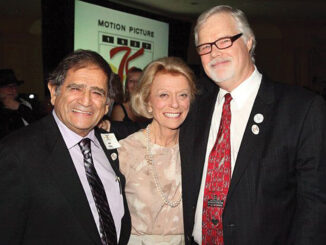
Reprinted from The New York Times by on February 2, 2021.
John J. Sweeney, a New York union researcher who climbed to the pinnacle of the American labor movement in the 1990s, leading the AFL-CIO for 14 years through an era of fading union membership but rising political influence, died on Monday at his home in Bethesda, Maryland. He was 86.
Carolyn Bobb, an AFL-CIO spokeswoman, confirmed the death. She did not specify the cause.
As president, from 1995 to 2009, of the nation’s largest labor federation — 56 unions with 10 million members near the end of his tenure — Sweeney flexed labor’s political muscle with thousands of volunteers and helped elect Barack Obama to the presidency in 2008. Over the years, he also helped elect Democrats to seats in Congress, to governorships and to state legislatures across the country. …
For decades in the 20th century, labor had not welcomed women, African-Americans, Latinos or Asian-Americans, often engaging in blatantly discriminatory tactics to preserve the dominance of white men in the workplace. Substantial but uneven gains had been achieved since the civil rights era of the 1960s, when unions began removing “whites only” clauses from their constitutions and bylaws.
But Sweeney, still facing lopsided demographics, plotted a sea change. He crusaded to bring women and minorities into the fold, often in leadership posts; made alliances with civil rights groups, students, college professors and the clergy; and championed low-wage workers, shifting away from the AFL-CIO’s traditional emphasis on protecting the best-paid union jobs. …
.
John J. Sweeney, AFL-CIO Leader Who Raised Unions’ Political Clout, Dies at 86
Reprinted from The Washington Post by on February 2, 2021.
Sweeney, who built the Service Employees International Union (SEIU) into the country’s third-largest labor union in the 1980s and 1990s, became president of the AFL-CIO in 1995. He took over the Washington-based trade association that represents the interests of dozens of labor unions after leading a power struggle that forced out the organization’s longtime leader, Lane Kirkland. …
Meyerson: The Man Who Realigned Labor
Reprinted from The American Prospect by Harold Meyerson on February 2, 2021.
“… In his years at the helm of SEIU, and then as president of the AFL-CIO from 1995 to 2009, Sweeney proved to be one of American labor’s most progressive leaders—a change agent in disguise,” writes Harold Meyerson in The American Prospect. “Like Joe Biden, he appeared to personify an ancien régime marked by hyphenated descriptors: old-school center-left working-class Irish American Catholicism. But he managed to reconcile that heritage with distinctly more progressive traditions and initiatives.
“At a time when his fellow union presidents were spending on average about 3 percent of their unions’ budgets on organizing, Sweeney was spending 30 percent at SEIU. During his tenure, SEIU membership grew from 625,000 to a little more than one million, even as the rest of the union movement continued to hemorrhage members. Much of that growth came from SEIU’s absorption of smaller unions, but a good deal came from organizing. The most celebrated organizing campaign of Sweeney’s tenure was the Justice for Janitors campaign, an effort notable for the janitors taking their case to the public through extensive street demonstrations, and for the strategic smarts that led the campaign (and its brilliant organizer, Steve Lerner) to target not the cleaning companies that nominally employed the janitors, but the owners and anchor tenants of the downtown skyscrapers the janitors cleaned.
“SEIU under Sweeney was the exception to the movement’s rule. Under the leadership of George Meany and his successor Lane Kirkland, the AFL-CIO, to which SEIU and the vast majority of American unions belonged at the time, had calcified into a backward-looking bureaucracy devoted as much if not more to its anti-communist foreign operations as to the advancement of American workers. With labor’s decline in numbers and clout, its political home, the Democratic Party, had moved to the right on economics. …






